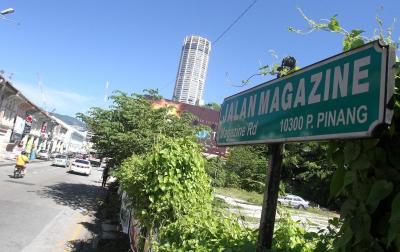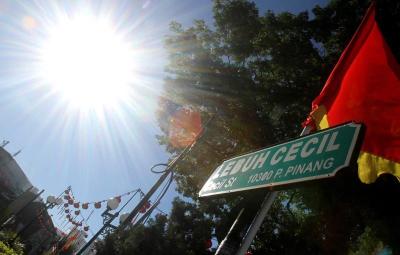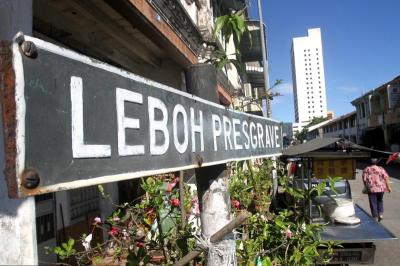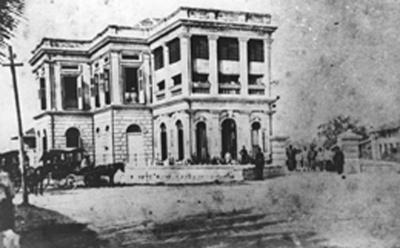Photos by ZHAFARAN NASIB
 Historical: Magazine Road is one of the main access roads to Komtar.
Historical: Magazine Road is one of the main access roads to Komtar.
IT IS still regarded as a rough, working class neighbourhood. The image of the iconic seven-street precinct has remained very much the same despite development in its vicinity.
The mainly Chinese-educated and Hokkien-speaking residents — who are mostly wage earners, traders and small businessmen — continue to make up the majority here.
According to one report, the houses along the streets were built in the late 19th century as a result of the “the spillover effect from the Francis Light Grid and Carnarvon Street/Prangin area.”
Thus, vegetable farms and wooden houses were soon replaced with brick houses, saw mills, foundries and cottage industries.
When Penang embarked on its massive urban renewal plan in the 1980s, which included the Komtar project that was right at the doorstep of this precinct, the area still remained somewhat of a no-man’s land, where triad activities thrived.
When I started out as a cub reporter at The Star office in Penang, I had to first earn my stripes on the crime beat.
Racing to crime scenes and visiting the mortuary in the middle of the night were part and parcel of work.
But there was also the routine morning press conference at the state police headquarters in Penang Road where the officers would brief us on the crime statistics.
It was common to see small-time thugs being made to squat in the room of an investigating officer attached to the anti-vice and gaming division while the officer chatted with us nonchalantly.
The gangsters, with their tattooed bodies, were more often than not, from one of the streets in the seven-street precinct.
 Seventh street: Cecil Street is named after Straits Settlement goverrnor Sir
Seventh street: Cecil Street is named after Straits Settlement goverrnor SirCecil Clementi.
There was always much excitement in the area. We would occasionally get calls from our police sources who tipped us off on clashes that broke out between rival gangs.
If we were quick enough, we would be at the crime scene to actually witness street fights before the cops arrived.
But in all fairness, many of the children of the original residents have done well in their lives. Often, with good education, they were able to move up the social ladder and lead transformed lives when they moved out of the area.
On a trip to Penang two weeks ago, I took a drive around the area. It is really a safe area despite the tough neighbourhood image of its past.
It has emerged as a popular tourist spot with its many colonial pre-war homes and shophouses. Although they are not included in the Unesco World Heritage Zone, these houses can fetch the same prices as those in Chulia Street and other surrounding areas.
Apart from sightseeing, foodies can find great food here as well. The duck meat koay teow soup at the Cecil Street food court is easily one of the best in Penang.
All the streets here retain their original names but the fact of the matter is that the locals only know them by their numbers.
Cecil Street, for example, is the seventh street which the Hokkiens call chit tiau lor and I doubt if even the residents know the history behind the person it was named after.
Fortunately, many Penangites and history buffs have taken it upon themselves to write extensively about this iconic precinct on the Internet.
According to blogger Boon Raymond, the seven major streets within the triangular grid or block borders Magazine Road, Jalan CY Choy (formerly Bridge Street) and Jalan Gurdwara (formerly Brick Kiln Road).
The seven main streets are Magazine Road or first street, which was named after the government gunpowder depot formerly located at the present Gama Supermarket. In Hokkein, it is called thau tiau lor or the first road.
Then, there is Noordin Street or the second street, which is named after HM Nordin, an Indian Muslim merchant. He is said to be one of the founders of the Kapitan Keling mosque.
 Still standing: Presgrave Street has retained its old signage.
Still standing: Presgrave Street has retained its old signage.
The third street is Presgrave Street — named after Edward Presgrave who founded the law firm of Presgrave and Matthews at Beach Street in 1898.
Presgrave & Matthews is one of the oldest legal firms in the Straits Settlement. According to the firm’s website, Presgrave was educated at the Edinburgh Academy and University.
In Penang, he was the solicitor-general and the president of the Penang Municipal Commission.
Today, Presgrave Street has gained a name for its street food and is within walking distance from Traders Hotel.
The fourth street is Tye Sin Street, which is named after Foo Tye Sin, a commissioner into the 1867 Penang Riots, which saw clashes between the Hai San and Ghee Hin gangs.
Foo was an unusual man of his time. The Hakka tin miner and businessman could speak English fluently as he was schooled at St Xavier’s Institution and Penang Free School. He was even a Justice of Peace.
Colonel Sir Henry McCallum has a road named after him at the fifth street. The colonial engineer of the Straits Settlement also has a street named after him in Singapore. After his stint in Penang and Singapore, he went on to become the Governor of Lagos, Newfoundland, Natal and Ceylon.
The sixth street or lak tiau lor is named after the importing agents, Katz Brothers Ltd which was set up in 1864 by Hermann Katz and his brother.
The brothers supplied pepper and other goods to ships. They did so well that they opened branches in Penang, Sumatra and even London and Frankfurt, according to local historian and publisher Khoo Salma Nasution.
 Landmark: Wisma Gama was once the site of the old police station and
Landmark: Wisma Gama was once the site of the old police station andgunpowder magazine. —Photo courtesy of Penang Public Library
The Katz Brothers brought in safe, locks and even sewing machines from Europe, among others, for sale in Penang.
The seventh street is named after another colonial officer, Sir Cecil Clementi, the Governor of the Straits Settlements between 1930 and 1934. He was a governor in Hong Kong prior to his posting in the Straits Settlement. In Singapore, Cecil Street is located near Raffles Singapore.
The Cantonese-speaking official was born in India to Colonel Montagu Clementi, a judge advocate general and his wife Isabel Collard. An Oxford graduate, he studied Sanskrit and classics to prepare himself for a role in the East.
Without doubt, there is plenty of history in the seven-street precinct and it is sad that they remain largely unknown to the residents and Penangites who pass by the area daily.
Just outside the precinct is the eighth street or Herriot Street — named after Stuart Herriot, a British merchant who stayed in Penang since the 1830s while ninth street — Sandilands Street — is named after another British businessman GM Sandilands.
According to Boon Raymond, the Ang Bin Hoey triad society had its headquarters at Sandilands Street.
At the end of December 1945, it was moved to 55, Maxwell Road. The triad society was dissolved in May 1946, but it continued its activities underground as a secret society.
According to an entry in Wikipedia, the Ang Bin Hoey, which is the Hokkien pronunciation of Hung Meng Hooi, was originally a society of the Ang people which was started during the Qing dynasty and was famed for its anti-Manchu activities.
In Penang, it evolved into local triads which gained notoriety for less noble pursuits.
Penang has become a magnet to many tourists because of its history and heritage. It is history that has made Penang such a unique tourist destination.
The federal and state governments should work together to ensure that this heritage is preserved to help Penangites keep history alive, and to remember those who have made the state what it is today.





